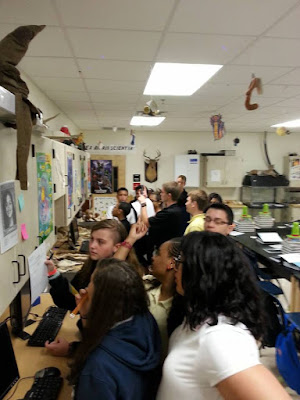Today's Quote:
Recap:
Thursday and Friday saw us learning about the concept mapping method of taking notes. I demonstrated for the classes that the majority of them see images in their mind when a word is spoken, but there are a few who see the actual word. I pointed out that brain research shows that most people would benefit from a concept map where they do not sit and take notes as written words, but rather chunks of related information. I reminded all students to use the best note taking strategy that works for them. When I do a notebook or journal check, all I need to see is that they are taking notes. It does not matter to me if those notes are Cornell notes, concept maps, or images they have doodled as long as they can explain to me what their notes are about. For the most part, I will give notes as concept maps. If students want a FREE concept mapping program they can go to: Concept maps for free. There is a mobile version for phones as well. Here is a link to our beginner's map: Scientific Method Concept map
Students were also given a worksheet on the 10 commandments of logic. These are various "fallacies" we try to avoid in science.
Students were reminded that they will have a binder check on Monday. On Thursday/Friday blog post the correct order for their science section was given with links to download anything they might be missing. I will ONLY check their planer and their science section. Scoring will be as follows- correct order 10pts, Agenda complete for science- 10 points, 7 handouts at 11.4 points each.
Students were given concept map notes over the two videos they watched on the scientific method. We covered the history of the scientific method including the main players in its development. There was Aristotle, who was painted pointing toward the ground symbolizing his school of thought based in nature and the idea that everything could be discovered if you just observed it long enough and relied on intuition (gut feeling). Next was Galileo- who stated that the truth was out there but had to be sought after and observed using a method. Finally, the most important was Abu al-Hasar, a Persian scientist who said there was truth to be discovered but it required a written set of organized steps and observations.
Steps in the Scientific Method:
- Ask a question or make an observation. These two things are interchangeable.
- Form a hypothesis Hypo= under Thesis= thought so a hypothesis is literally the underlying through of what you think will happen in your experiment or project.
- Must be testable
- Must be written as an If- Then statement (If A then B)
- Must be logical in nature
- Design and perform an experiment- we stopped here and said we would finish next week.
Students then had their first look at the crime scene.













No comments:
Post a Comment